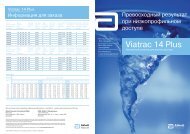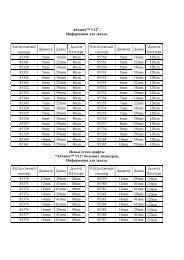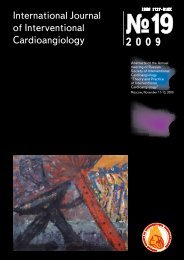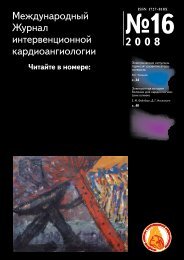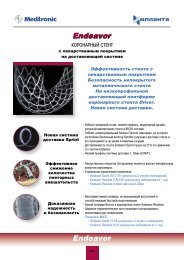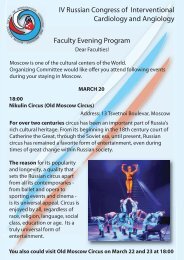Results of Coronary Stenting using the Stents with
Results of Coronary Stenting using the Stents with
Results of Coronary Stenting using the Stents with
Create successful ePaper yourself
Turn your PDF publications into a flip-book with our unique Google optimized e-Paper software.
Interventional cardiology<br />
Simultaneous Endovascular <strong>Coronary</strong> Angioplasty (Direct<br />
<strong>Stenting</strong> <strong>of</strong> <strong>the</strong> Marginal Branch, Recanalization and<br />
<strong>Stenting</strong> <strong>of</strong> “Chronic” Occlusion <strong>of</strong> <strong>the</strong> LAD) and Closure<br />
<strong>of</strong> Secundum Atrial Septal Defect<br />
D.G. Iosseliani 1 , A.G. Koledinsky, E.Yu.Danilov, I.A. Kovalchuk, V.A. Kriukov, A.Zh. Abildinova, A.N.Rogatova,<br />
I.G. Kibizova, A.V. Stepanov, A.V. Novachly, P.S. Vasiliev, V.S. Chekanov<br />
Moscow City Center <strong>of</strong> Interventional Cardioangiology, Moscow, Russia<br />
The authors present a clinical case <strong>of</strong> successful simultaneous endovascular myocardial revascularization for<br />
stenotic and occlusive coronary lesion and closure <strong>of</strong> ASD secundum. The dilatation <strong>of</strong> <strong>the</strong> LAD and <strong>the</strong> OMB<br />
<strong>with</strong> balloon ca<strong>the</strong>ter has been performed followed by DES implantation. During <strong>the</strong> second stage endovascular<br />
closure <strong>of</strong> <strong>the</strong> ASD <strong>using</strong> Amplatzer occluder has been performed. 16 similar cases have been described<br />
in <strong>the</strong> literature. The issue <strong>of</strong> reasonability <strong>of</strong> simultaneous performance <strong>of</strong> two independent endovascular<br />
procedures remains open. The necessity <strong>of</strong> ASD closure is dictated by <strong>the</strong> possibility <strong>of</strong> serious complications,<br />
such as ischemic stroke and migraine, in <strong>the</strong> presence <strong>of</strong> an open interatrial communication.<br />
Keywords: ASD, coronary stenting, occluder, coronary artery disease.<br />
Atrial septal defect comprises 5 to 15% <strong>of</strong> al congenital<br />
heart defects (3). In <strong>the</strong> absence <strong>of</strong> radical correction<br />
30% <strong>of</strong> patients <strong>with</strong> this pathology die <strong>with</strong>in<br />
<strong>the</strong> first 20 years <strong>of</strong> life (4). However <strong>the</strong> reasonability<br />
<strong>of</strong> this defect correction in patients who survived this<br />
age is not evident. In some patients <strong>the</strong> atrial septal<br />
defect (ASD) does not produce a significant impact<br />
on intracardiac hemodynamics (1), while in o<strong>the</strong>rs<br />
<strong>the</strong> ASD can lead to progressive volume overload<br />
and right heart dilatation, development <strong>of</strong> arrhythmias<br />
and persistent pulmonary hypertension (6).<br />
Moreover, independently <strong>of</strong> <strong>the</strong> state <strong>of</strong> intracardiac<br />
hemodynamics, in all patients <strong>with</strong> ASD pathological<br />
interatrial communications can cause such serious<br />
complications as migraine and ischemic stroke (13).<br />
Also <strong>with</strong> <strong>the</strong> course <strong>of</strong> time such patients can develop<br />
coronary artery disease (CAD). In case <strong>of</strong> AMI and<br />
postinfarction cardiosclerosis <strong>the</strong> presence <strong>of</strong> pathological<br />
blood stream <strong>with</strong>in <strong>the</strong> heart chambers can<br />
contribute to a more marked postinfarction remodeling<br />
<strong>of</strong> <strong>the</strong> left ventricle, volume overload, right heart<br />
dilatation and development <strong>of</strong> significant circulatory<br />
insufficiency. If such patients develop clinical signs<br />
<strong>of</strong> coronary artery disease, <strong>the</strong>y should be examined<br />
for <strong>the</strong> detection <strong>of</strong> coronary pathology, and if it is<br />
revealed, a special treatment is mandatory. Thus, all<br />
grown-up patients <strong>with</strong> ASD should be continuously<br />
followed in order to receive timely medical care, including<br />
endovascular and surgical treatment.<br />
Moscow City Center <strong>of</strong> Interventional Cardioangiology<br />
has an experience <strong>with</strong> simultaneous treatment<br />
1<br />
Address for correspondence:<br />
Pr<strong>of</strong>. David Iosseliani<br />
Moscow City Center <strong>of</strong> uinterventional Cardioangiology<br />
5, Sverchkov per., Moscow, 101000, Russia<br />
Tel. +7 495 624 96 36<br />
Fax +7 495 624 67 33<br />
e-mail: davidgi@mail.ru<br />
Manuscript received on July 19, 2011<br />
Accepted for publication on September 05, 2011<br />
<strong>of</strong> ASD and CAD in three patients. We describe one<br />
clinical case <strong>of</strong> successful simultaneous endovascular<br />
myocardial revascularization for stenotic and occlusive<br />
lesions <strong>of</strong> <strong>the</strong> coronary arteries and closure <strong>of</strong><br />
a secundum ASD.<br />
The patient P., 72 years old, was admitted to<br />
Moscow City Center <strong>of</strong> Interventional Cardioangiology<br />
<strong>with</strong> <strong>the</strong> diagnosis: CAD; angina <strong>of</strong> effort class<br />
II; postinfarction cardiosclerosis; 3rd degree arterial<br />
hypertension; circulatory insufficiency class I; congenital<br />
heart defect: secundum ASD; dysplasia <strong>of</strong> <strong>the</strong><br />
interatrial septum.<br />
The analysis <strong>of</strong> medical history revealed a longstanding<br />
arterial hypertension (max. to 200/110 mm<br />
Hg). The patient did not follow a regular hypotensive<br />
<strong>the</strong>rapy. In 2004, <strong>with</strong>out prior angina, he had a<br />
Q-wave anterior myocardial infarction, and received<br />
systemic thrombolysis <strong>with</strong> Alteplasa. Transesophageal<br />
EchoCG and MRI performed on <strong>the</strong> same occasion revealed<br />
for <strong>the</strong> first time a congenital heart defect — secundum<br />
atrial septal defect (ASD) <strong>with</strong> volume overload<br />
<strong>of</strong> <strong>the</strong> right heart. Endovascular ASD closure was suggested,<br />
but <strong>the</strong> patient refused this procedure. After that<br />
he started complaining <strong>of</strong> angina pain and heart rhythm<br />
disturbances (extrasystoles) and had several hospital<br />
stays. Selective coronary angiography performed in<br />
2007 revealed an occlusion in <strong>the</strong> proximal segment <strong>of</strong><br />
<strong>the</strong> LAD and a stenotic lesion in <strong>the</strong> marginal branch.<br />
The patient refused special treatment and continued<br />
conservative <strong>the</strong>rapy. In October 2010 he applied to <strong>the</strong><br />
consultative and diagnostic department <strong>of</strong> Moscow City<br />
Center <strong>of</strong> Interventional Cardioangiology complaining <strong>of</strong><br />
decreased physical tolerance, increased fatigue, dyspnea<br />
<strong>of</strong> effort and heart rhythm disturbances. Multihelix<br />
computed tomography confirmed <strong>the</strong> diagnosis <strong>of</strong> an<br />
oval-shaped ASD secundum located in <strong>the</strong> upper part<br />
<strong>of</strong> <strong>the</strong> septum, measuring 1.07 х 1.25 cm and surrounded<br />
by an aplastic interatrial septum (IAS) <strong>with</strong> marked<br />
aneurysmatic bulging into <strong>the</strong> right atrium (Fig. 1).<br />
10<br />
(№ 26, 2011)




